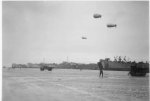NavSource Online: Amphibious Photo Archive
USS LST-30
International Radio Call Sign:
November - Foxtrot - Lima - Oscar
NFLO
Awards, Citations and Campaign Ribbons
Precedence of awards is from left to right
American Campaign Medal - Europe-Africa-Middle East Campaign Medal (1) - World War II Victory Medal

